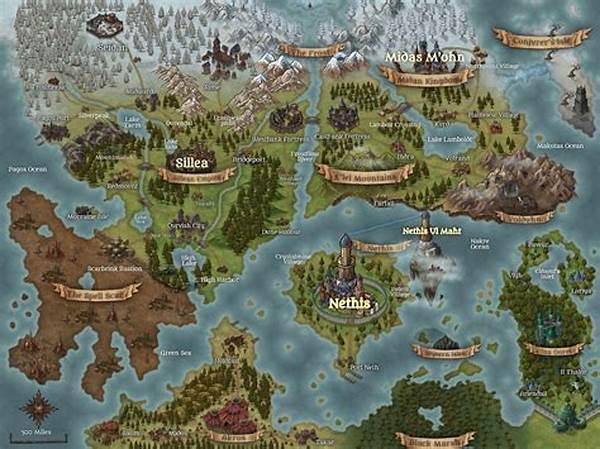Creating immense fictional worlds is an art as much as it’s a science. It involves a delicate balance between creativity and organization. To structure vast fictional worlds, authors must craft settings that are immersive, believable, and rich with detail. This task is not just about drawing maps or inventing alien languages, but about building a coherent universe where every aspect is interconnected, yet free for imaginative exploration. Aspiring writers may often wonder how to undertake this monumental task. While there is no one-size-fits-all approach, understanding the fundamental principles can pave the way for constructing engaging and complex fictional realms.
Read Now : Improving Art Display With Technology
The Foundation of World-Building
At the heart of structuring vast fictional worlds lies a solid foundation. Writers start with the core idea or theme that defines the world. This theme becomes the backbone around which various aspects of the fictional world coalesce. It might be a particular social, political, or cultural framework, or even a unique aspect of nature. Once the foundation is laid, multiple layers of detail are meticulously built upon it—geography, history, society, custom, and laws. The goal is to create an environment that supports the narrative while leaving room for the plot and characters to evolve organically. Structuring vast fictional worlds requires foresight to anticipate potential inconsistencies and creativity to resolve them before they arise.
One of the critical elements in this process is developing a consistent set of rules that govern the world. Whether it’s the laws of physics, magic systems, or societal norms, these rules ensure that the world operates smoothly and remains believable. Authors should consider how different elements interact and affect one another, creating a vibrant tapestry full of possibilities while ensuring a logical progression of events. As the structure becomes more complex, keeping track of these elements can become challenging, but detailed notes and world-building tools can aid in maintaining clarity and coherence throughout the writing process.
Key Elements of World-Building
1. Consistency and Coherence
In structuring vast fictional worlds, maintaining consistency is crucial. Every element must align with the established rules, avoiding contradictions that could disrupt immersion.
2. Geographical Diversity
Diverse landscapes add depth. Attention to geographical details makes the world more tangible and provides varied settings for the storyline.
3. Cultural Richness
Cultures should be distinct yet believable. Their evolution and interaction enrich the narrative, much like complex characters do.
4. Historical Depth
A well-developed history can influence present events, making the world feel lived-in. It adds layers and context to current conflicts and relationships.
5. Magic and Technology Systems
Structuring vast fictional worlds often includes defining the role of magic or technology, establishing rules that govern their use within the world and explore their implications on society.
The Role of Characters and Plots
Character and plot development are intrinsically linked to structuring vast fictional worlds. Characters should be products of their environment, shaped by the culture, society, and contexts they inhabit. Their beliefs, behaviors, and relationships should reflect the world’s intricacies, making them authentic and relatable. This connection deepens readers’ investment, as they see characters as an integral part of the universe rather than as separate entities. Similarly, the plot should be intertwined with the world’s structure, evolving naturally from its features and conflicts.
Plots in vast worlds often involve complex storylines that take full advantage of the setting’s depth. Multiple plotlines might interweave, allowing for layered storytelling where each thread enriches the others. As challenges arise, characters navigate a marvelously structured universe, facing dilemmas unique to that world’s context. This synergy between plot and setting is what turns a narrative from a simple story to an epic tale, capable of captivating a reader’s imagination over extensive volumes.
Challenges in World-Building
1. Avoiding Information Overload
Structuring vast fictional worlds can lead to an excess of detail. Balance is key to keep the narrative engaging without overwhelming the reader.
2. Maintaining Engagement
Writers must ensure the world supports an engaging story, rather than overshadowing it with complexity or detail.
3. Developing Unique Elements
Differentiating the world with unique features helps it stand out and intrigue the audience.
4. Balancing Realism and Imagination
A believable world requires elements of realism, but imagination is needed to craft something truly captivating.
5. Sustaining Cohesion
Read Now : Low-cost Graphic Design Programs
As the world expands, ensure all elements—geographic, cultural, historical—maintain a cohesive and logical relationship.
6. Continuous Evolution
Worlds should evolve, reflecting changes due to time or narrative progression, offering new dynamics and freshness.
7. Engaging Characters
Characters should naturally arise from the world’s elements, ensuring they are compelling and relevant.
8. Integrating Technology and Magic
These elements must fit seamlessly into the world without disrupting its logic or coherence.
9. Adapting to Reader Expectations
Understanding and sometimes subverting reader expectations can lead to a more novel and exciting experience.
10. Ensuring Narrative Flexibility
The structured detail shouldn’t restrict narrative possibilities; it should instead provide a springboard for creative storytelling.
The Evolving Nature of World-Building
Structuring vast fictional worlds is not a static process. It demands adaptability and a willingness to evolve. As stories unfold and characters develop, the world may need to shift to accommodate new directions. Writers should embrace the flexibility of their creations, allowing new insights to refine and expand their universe.
In the early stages, stepping back and examining the world from a macroscopic viewpoint can be beneficial. This broader perspective aids in identifying overarching themes and connections that might be lost in a detailed view. Structuring vast fictional worlds involves a continuum of adjustments, where each layer of complexity adds depth to the storytelling. Equipping oneself with patience and artistic courage is essential to delve into the re-imagining and rewriting spaces of world-building. In doing so, authors may discover unforeseen paths that lead to more innovative and compelling narratives.
Bridging Realism and Creativity
Balancing realism and creativity is crucial when structuring vast fictional worlds. Reality provides a comfortable anchor for readers, making a world immersive and relatable. Yet, creativity is what breathes life into it, allowing it to transcend the ordinary. The interplay between realistic and fantastical elements shapes a space where both the tangible and the ethereal coexist seamlessly.
Characters benefit from this balance too. Their development should reflect the world’s nuances, showcasing both strengths and internal conflicts. Intricately designed settings and expansive lore demand plots that challenge characters while opening avenues for growth and transformation. Paramount in structuring vast fictional worlds is the continuous collision and merging of the real and the imaginative, creating a literary tapestry that both intrigues and captivates.
Crafting Depth and Detail
In structuring vast fictional worlds, crafting depth and detail is a meticulous endeavor. Authors delve into every facet of their creation, from the mundane to the extraordinary. Even the simplest objects can carry significance within the broader tapestry of the world. This richness of detail is what forms the backbone of authenticity, encouraging readers to fully suspend their disbelief.
Detail also emerges in language and dialogue, wherein characters express themselves in ways rooted in their cultural and societal backgrounds. Such intricacies heighten the narrative, offering layers through which readers may explore the philosophical and thematic questions posed by the story. Dialogues become critical, serving as tools of exposition and subtle world-building that reveal as much by what is said as by what is left unsaid.
Deep and immersive world-building becomes the stage upon which the drama of human— or otherwise— experience unfolds. Characters act against a backdrop painted with elements that resonate with both echoes of reality and flights of fantasy. It’s this dance between depth and detail that ensures a fictional world isn’t just visited, but truly experienced.
Engaging with World-Building Principles
Engaging with the principles of structuring vast fictional worlds means diving into a disciplined yet creative process. Writers must amalgamate extensive research with limitless invention, thriving in the balance thereof. By anchoring their expansive ideas on foundational storytelling principles, creators can craft realms that are inviting yet complex.
World-building should also be seen as interactive. It invites observation, critique, and adaptation, evolving alongside its audience’s imagination and reflection. By fostering this interactive dynamic, authors open their worlds to growth and sustainability. Ultimately, adeptly structuring vast fictional worlds goes beyond mere construction; it’s an invitation to explore, learn, and experience the endless possibilities housed within the written word.



